Air Pollution Associates with Cancer Incidences in Poland
Abstract
1. Introduction
2. Methods
- Dust collectors operating on the basis of reference methodologies. Collectors are produced by the companies Comde Derenda GmbH, MCZ GmbH, and Sven Leckel.
- Meters operating in online measurement mode, according to the methodology equivalent to the reference method. These meters are manufactured by the companies Envea, Grimm Aerosol Technik, PALAS GmbH, and Thermo Fisher Scientific (US).
3. Results
4. Discussion
5. Conclusions
- There are strong correlations in given provinces with the type of cancer.
- Based on the analysis, it was found that the formation of C17 and C18 disease (colorectal cancer) is the most strongly correlated with the emission of nitrogen oxides in the Masovia province and in the West Pomeranian region.
- Analysis of the influence of the type of air pollutants on the formation of selected types of cancer showed that:
- −
- for lung cancer, the release of PM2.5 pollution plays the most important role,
- −
- the most important issue in colorectal cancer is the emission of nitrogen dioxide.
- Emissions of nitrogen dioxide, as well as arsenic and benzoalfapiren compounds found in suspended dust, have an effect on the development of large intestinal diseases (C18).
Author Contributions
Funding
Acknowledgments
Conflicts of Interest
References
- Pooley, F.D.; Mille, M. Composition of Air Pollution Particles. In Air Pollution and Health; Academic Press: Cambridge, MA, USA, 1999. [Google Scholar]
- Gorham, E.D.; Garland, C.F.; Garland, F.C. Acid haze air pollution and breast and colon cancer mortality in 20 Canadian cities. Can. J. Public Health 1989, 80, 96–100. [Google Scholar] [PubMed]
- Turner, M.C.; Krewski, D.; Diver, W.R.; Pope, C.A.; Burnett, R.T.; Jerrett, M.; Marshall, J.D.; Gapstur, S.M. Ambient Air Pollution and Cancer Mortality in the Cancer Prevention Study II. Environ. Health Perspect. 2017, 125, 087013. [Google Scholar] [CrossRef] [PubMed]
- Grant, W.B. Air Pollution in Relation to U.S. Cancer Mortality Rates: An Ecological Study; Likely Role of Carbonaceous Aerosols and Polycyclic Aromatic Hydrocarbons. Anticancer Res. 2009, 29, 3537–3545. [Google Scholar] [PubMed]
- López-Abente, G.; García-Pérez, J.; Fernández-Navarro, P.; Boldo, E.; Ramis, R. Colorectal cancer mortality and industrial pollution in Spain. BMC Public Health 2012, 12, 589. [Google Scholar] [CrossRef] [PubMed]
- Stockfisch, J.; Markowski, J.; Pilch, J.; Zemła, B.; Dziubdziela, W.; Likus, W.; Bajor, G. Impact of environmental pollution on the incidence of malignant neoplasms of upper respiratory tract in the population of Mysłowice, Imielin and Chełm Śląski. Med. Środowiskowa Environ. Med. 2014, 17, 16–24. [Google Scholar]
- Kapka, L.; Zemła, B.F.; Kozłowska, A.; Olewińska, E.; Pawlas, N. Air quality vs morbidity to lung cancer in selected provinces and localities of the silesian region. Prz. Epidemiol. 2009, 63, 437–442. [Google Scholar]
- Jarosz, K.; Chudzik, R.; Gołębiowska, M.; Gołębiowska, B. Impact of air pollution in Poland to the incidence of the lung cancer in adults (2010–2014). Rev. Res. Cancer Treat. 2017, 3, 5–13. [Google Scholar]
- Wojciechowska, U.; Didkowska, J.; Koćmiel, A. Cancer in Poland as a public health problem. Stud. Demogr. 2012, 1, 153–166. [Google Scholar]
- Wojciechowska, U.; Didkowska, J. Illnesses and deaths from malignant tumors in Poland. National Cancer Registry, Oncology Center, Maria Skłodowska-Curie Institute. Available online: http://onkologia.org.pl/raporty/ (accessed on 24 August 2018).
- Su, S.-Y.; Liaw, Y.-P.; Jhuang, J.-R.; Hsu, S.-Y.; Chiang, C.-J.; Yang, Y.-W.; Lee, W.-C. Associations between ambient air pollution and cancer incidence in Taiwan: An ecological study of geographical variations. BMC Public Health 2019, 19, 1–8. [Google Scholar] [CrossRef] [PubMed]
- Statistics Data from Chief Inspectorate for Environmental Protection. Measurement Data Bank. Available online: http://powietrze.gios.gov.pl/pjp/archives/downloadFile/244 (accessed on 24 August 2018).
- Gagolewski, M.; Bartoszuk, M.; Cena, A. Data Processing and Analysis in Python; PWN: Warsaw, Poland, 2016. [Google Scholar]
- Pauly, O. Random Forests for Medical Applications. Ph.D. Thesis, The Technical University of Munich, Munich, Germany, 2012. [Google Scholar]
- Badyda, A.J.; Grellier, J.; Dąbrowiecki, P. Ambient PM2.5 Exposure and Mortality Due to Lung Cancer and Cardiopulmonary Diseases in Polish Cities. Adv. Exp. Med. Biol. 2017, 944, 9–17. [Google Scholar] [PubMed]
- Chorazy, M. Polish pollution. Nature 1992, 360, 704. [Google Scholar] [CrossRef] [PubMed]
- Chudzik, R.; Rybojad, P.; Jarosz-Chudzik, K.; Sawicki, M.; Rybojad, B.; Panasiuk, L. Air pollution: How many cigarettes does each Pole ‘smoke’ every year and how does it influence health, with special respect to lung cancer? Ann. Agric. Environ. Med. 2019, 26, 566–571. [Google Scholar] [CrossRef] [PubMed]
- Just, J.; Maziarka, S.; Dlugasiewicz, M. Umieralność na raka płuc mieszkańców wybranych miast polskich a zanieczyszczenia powietrza atmosferycznego. Rocz. Panstw. Zakl. Hig. 1969, 20, 515. [Google Scholar] [PubMed]
- Radziszewska, A.; Karczmarek-Borowska, B.; Grądalska-Lampart, M.; Filip, A.A. Epidemiologia, profilaktyka i czynniki ryzyka zachorowania na raka płuca. Pol. Merkur. Lekarski. 2015, 38, 113–118. [Google Scholar] [PubMed]
- Wyrwicz, L.; Gryglewicz, J.; Chrostowski Sz Domańska-Sadynica, M.; Ambroziewicz, B. The Situation of a Patient with Colorectal Cancer in Poland. Suggestions for Changes. Warsaw. 2017. Available online: https://www.pkopo.pl/userfiles/file/Raportrakjelita2017light.pdf (accessed on 24 August 2018).
- Schulze, F.; Gao, X.; Virzonis, D.; Damiati, S.; Schneider, M.R.; Kodzius, R. Air Quality Effects on Human Health and Approaches for Its Assessment through Microfluidic Chips. Genes 2017, 8, 244. [Google Scholar] [CrossRef]
- Murata, M.; Takayama, K.; Fukuma, S.; Okamoto, N.; Kato, I.; Hanai, A.; Nakayama, H.; Fujiwara, K.; Ikeda, T.; Fujimoto, I. A comparative epidemiologic study on geographic distributions of cancers of the lung and the large intestine in Japan. Jpn. J. Cancer Res. 1988, 79, 1005–1016. [Google Scholar] [CrossRef]
- García-Pérez, J.; Fernández-Navarro, P.; Castelló, A.; López-Cima, M.F.; Ramis, R.; Boldo, E.; López-Abente, G. Cancer mortality in towns in the vicinity of incinerators and installations for the recovery or disposal of hazardous waste. Environ. Int. 2013, 51, 31–44. [Google Scholar] [CrossRef] [PubMed]
- Ranzi, A.; Fano, V.; Erspamer, L.; Lauriola, P.; Perucci, C.A.; Forastiere, F. Mortality and morbidity among people living close to incinerators: A cohort study based on dispersion modeling for exposure assessment. Environ. Health 2011, 10, 22. [Google Scholar] [CrossRef] [PubMed]
- Ćwik, P. What Does Smog Do? Nitrogen Oxides (#1). Available online: https://smoglab.pl/co-i-jak-nas-truje-tlenki-azotu-1/ (accessed on 24 August 2018).
- Chwaleba, A.; Olejnik, A.; Rapacki, T.; Tuśnio, N. Analysis of capability of air pollution monitoring from an unmanned aircraft. Aviation 2014, 18, 13–19. [Google Scholar] [CrossRef]
- Berner, B.; Chojnacki, J. Using drones to environmental pollution monitoring. Autobusy 2017, 18, 57–60. [Google Scholar]
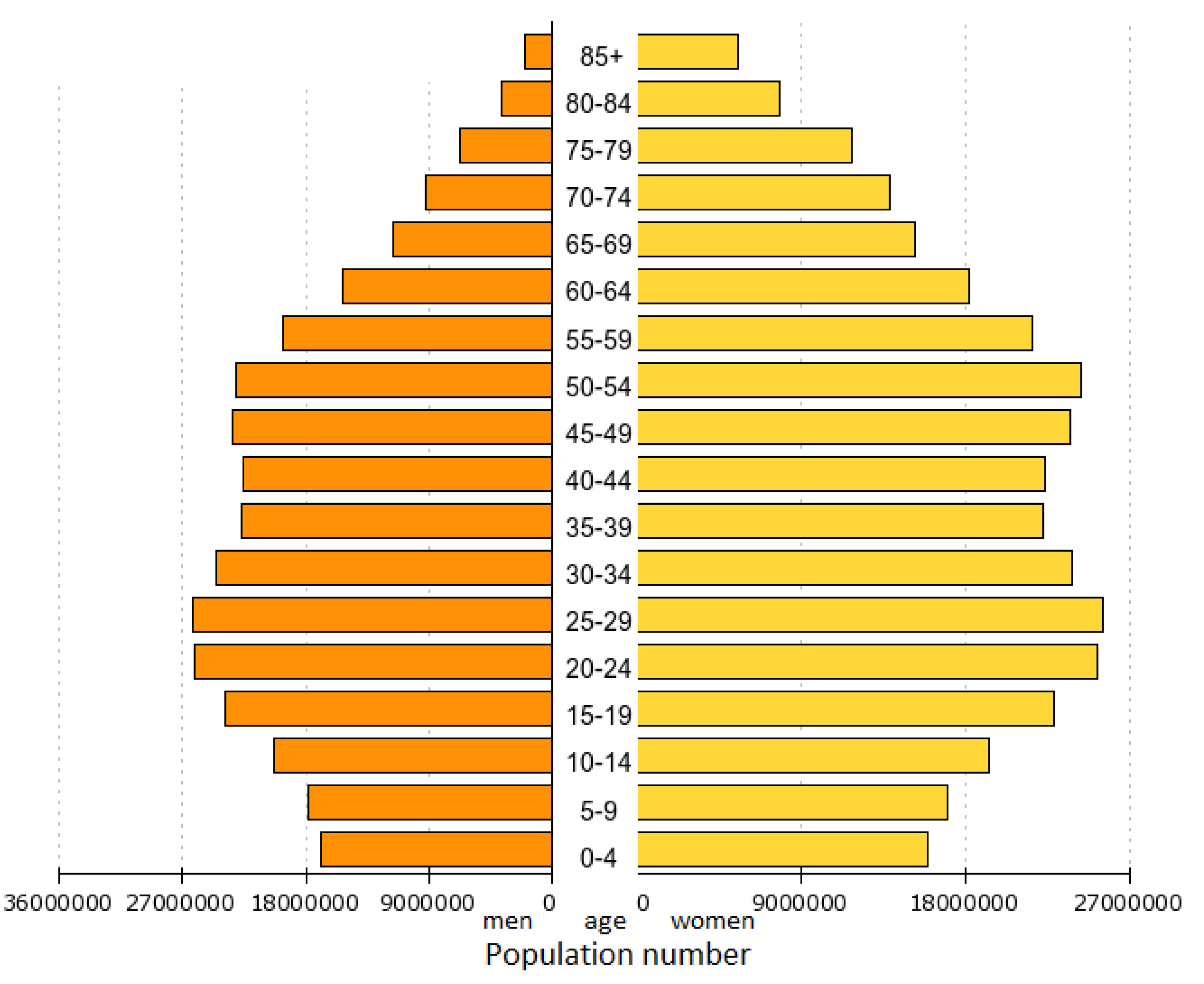
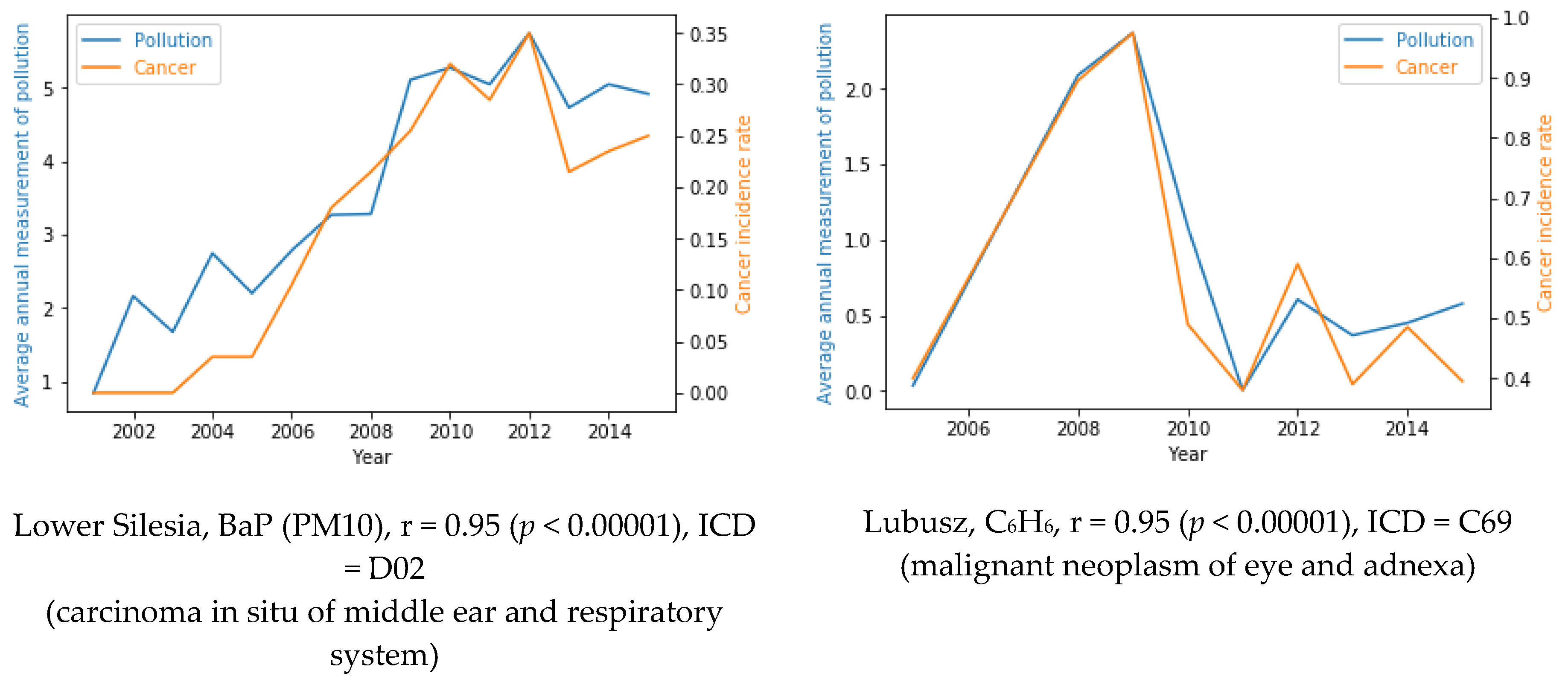
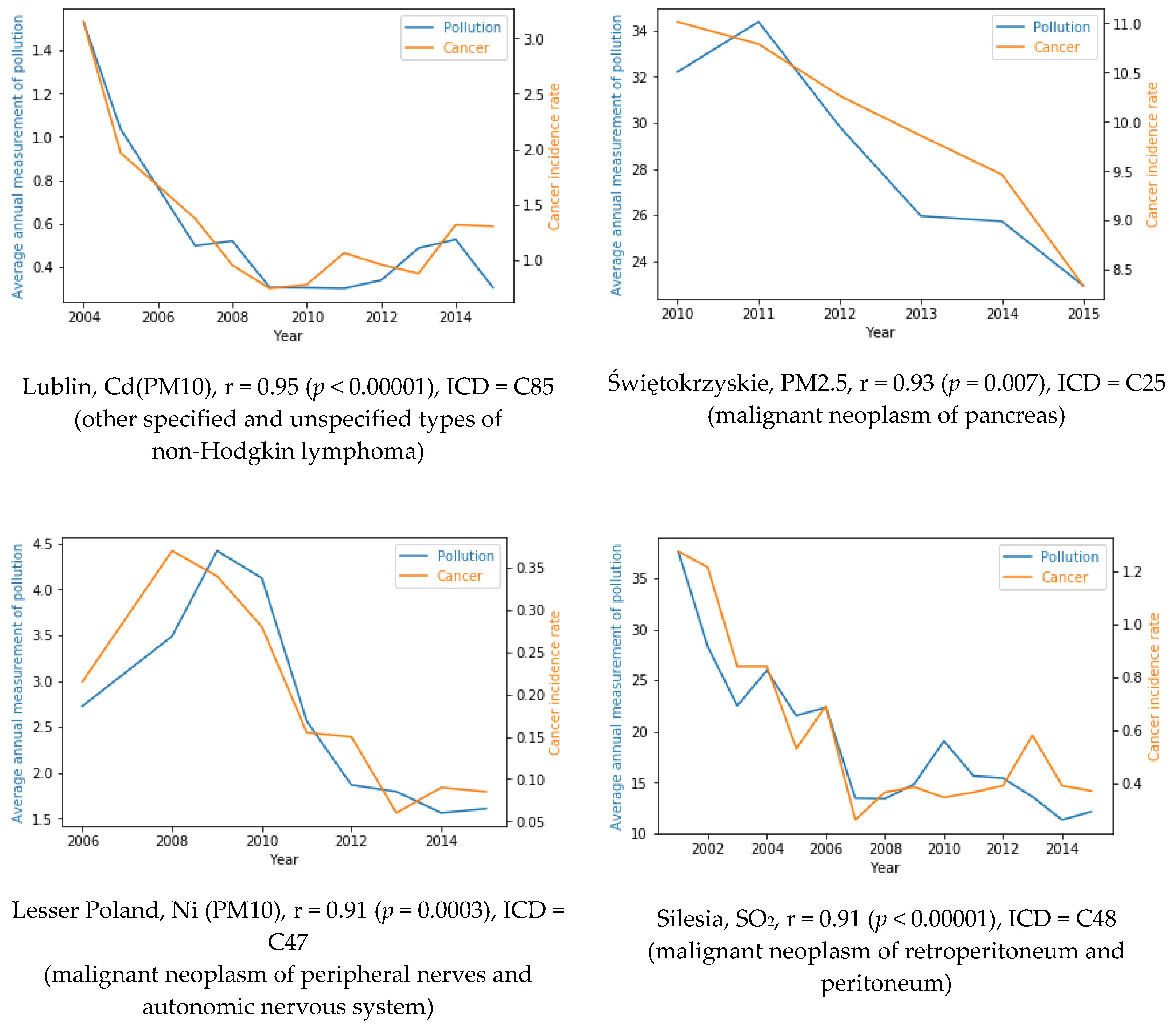
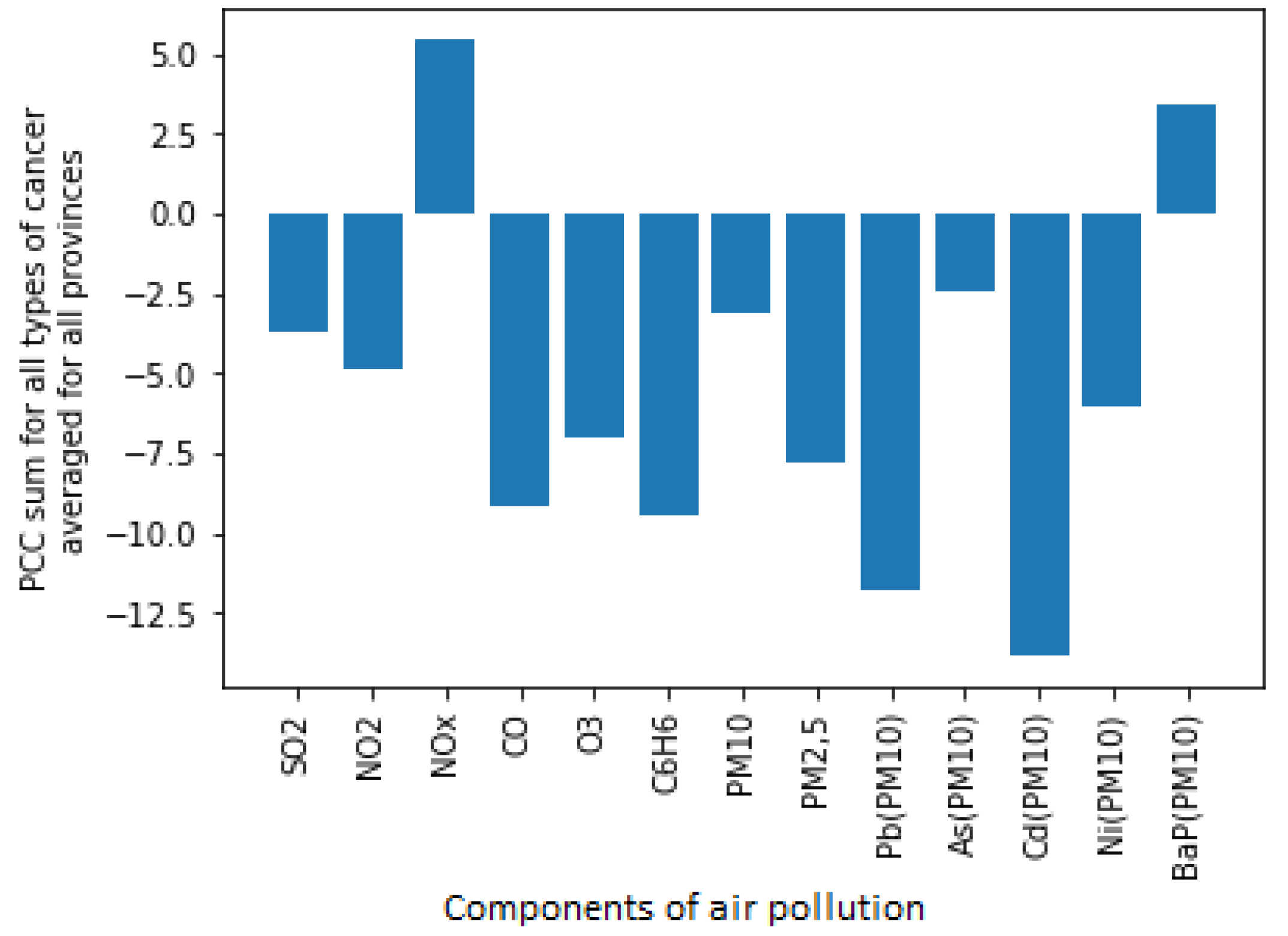
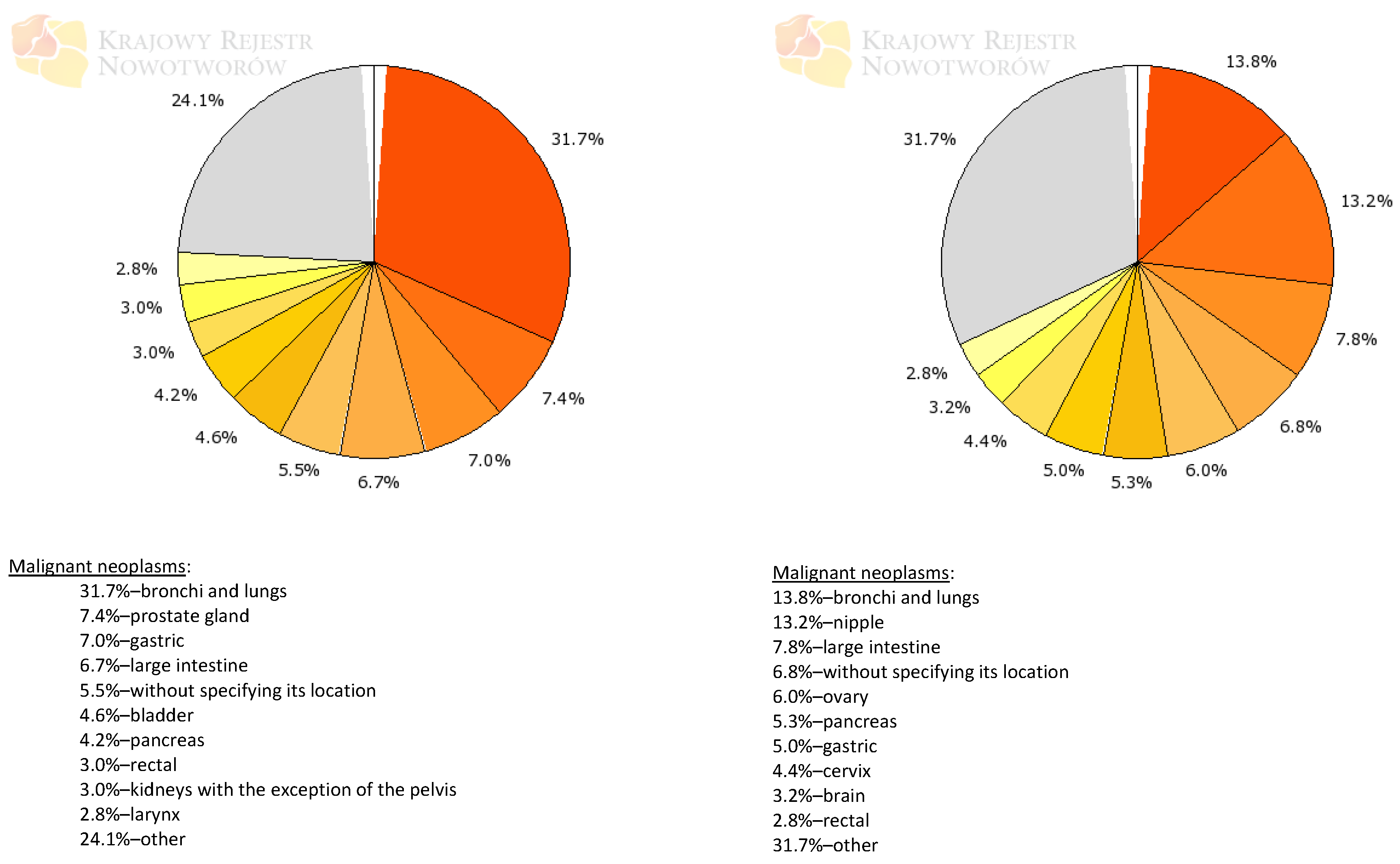

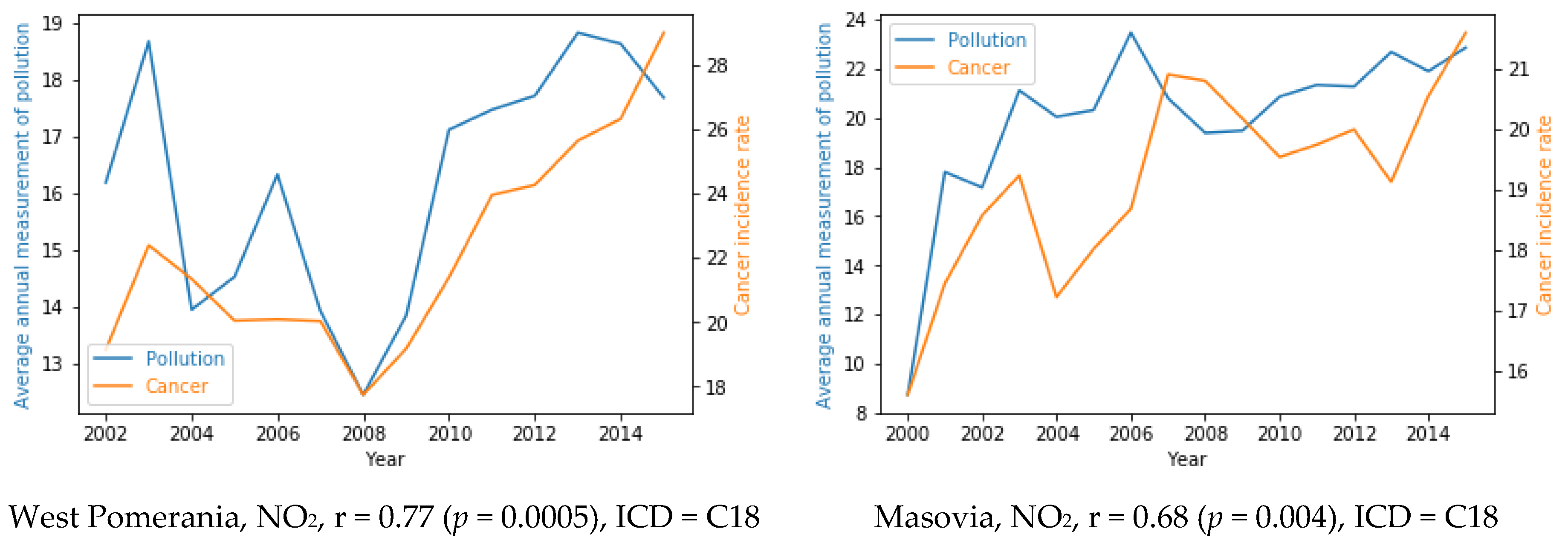

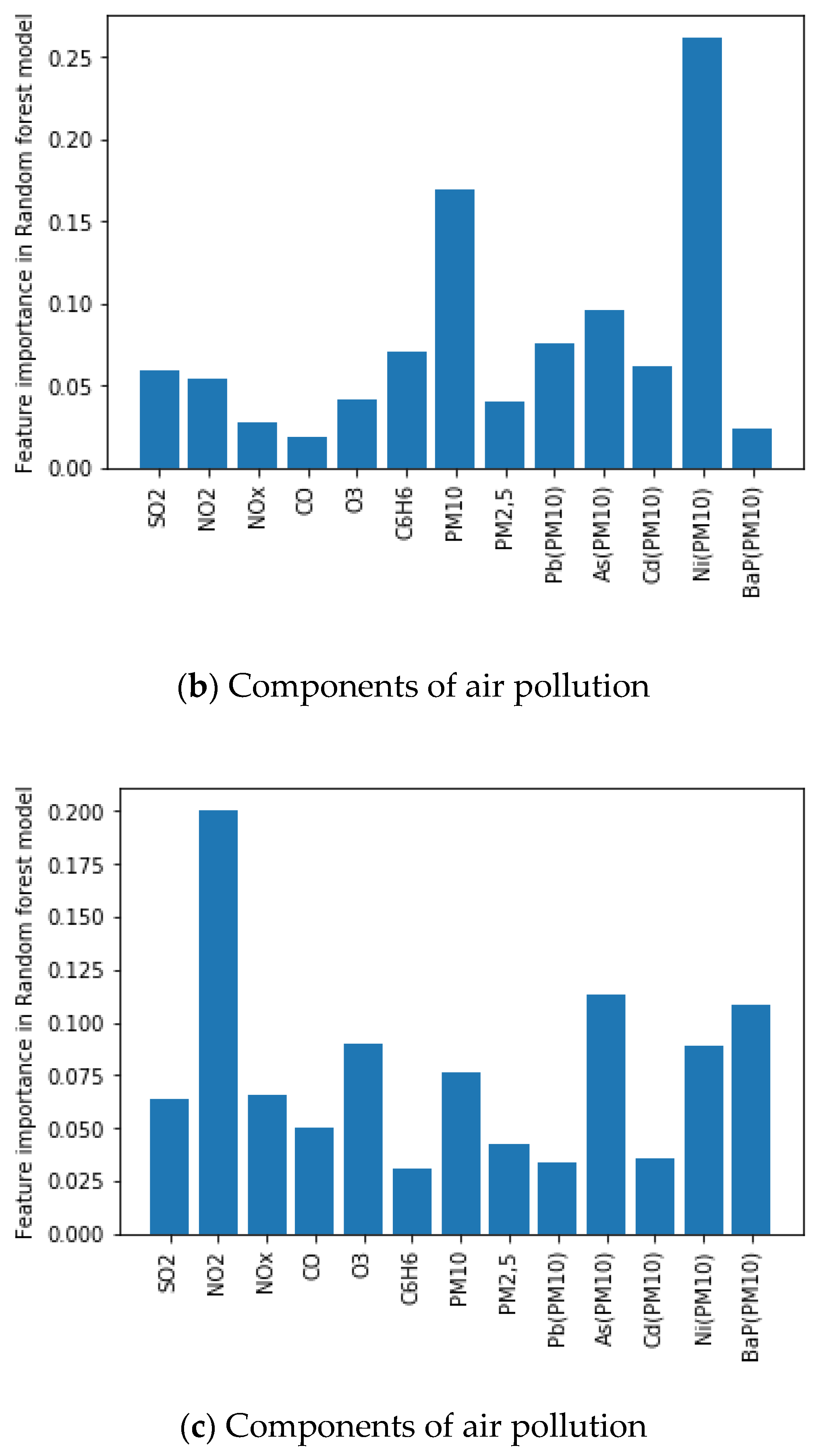
| Types of Pollutants | Levels of Pollutants | Study Design | Target Population | Reference | |
|---|---|---|---|---|---|
| 1. | SO2 | high concentrations (acid haze) | age-adjusted breast and colon cancer mortality rates were examined | 20 cities in Canada | [2] |
| 2. | PM2.5, NO2, O3 | particulate matter concentrations were estimated for the participant residence | mortality due to kidney, bladder and colorectal cancers were observed | 623,048 participants | [3] |
| 3. | acid deposition, carbonaceous aerosols, polycyclic aromatic hydrocarbons | not only ambient pollution but occupational exposure, smoking, and polycyclic aromatic hydrocarbons (PAH) | age-adjusted, gender-specific and race-specific cancer mortality rates were obtained (20 groups of cancer) | population of the United States (data up to 1994) | [4] |
| 4. | pollution emitted by various industries | population exposure to industrial pollution was estimated by reference to the distance from town centroids to industrial facilities | the relative risks (RR) of towns situated at a short distance from industrial installations were estimated (colorectal cancer mortality) | 8098 towns in Spain | [5] |
| 5. | SO2, NO2, NOx, CO, O3, C6H6, PM10, PM2.5, Pb(PM10), As(PM10), Cd(PM10), Ni(PM10), BaP(PM10) | measurement data of the Chief Inspectorate of Environmental Protection (Poland) | correlation of air pollution with selected cancer cases by 16 provinces | 2,153,652 cancer cases in Poland (2000–2015) | our study |
| Parameter | powietrze.gios.gov.pl | onkologia.org.pl |
|---|---|---|
| Years | 17 (2000–2016) | 17 (1999–2015) |
| Number of provinces | 16 | 16 |
| Number of | pollutants: 13 | neoplasms: 101 (C00-D09) |
| Method of obtaining data | Excel file | POST request * |
| Province | NO2 ICD/r | NOx ICD/r | Province | NO2 ICD/r | NOx ICD/r |
|---|---|---|---|---|---|
| Lower Silesia (DS) | C96/0.65 p = 0.006 | C83/0.83 p = 0.00007 | Silesia (SL) | C33/0.61 p = 0.012 | C57/0.70 p = 0.003 |
| Kujawy-Pomerania (KP) | D07/0.55 p = 0.027 | D07/0.75 p = 0.0008 | Świętokrzyskie (SK) | C23/0.79 p = 0.0003 | C10/0.74 p = 0.001 |
| Lublin (LU) | C91/0.85 p = 0.00003 | C95/0.78 p = 0.0004 | Warmia-Masuria (WN) | C49/0.53 p = 0.035 | C24/0.80 p = 0.0002 |
| Lubusz (LB) | C57/0.72 p = 0.002 | D07/0.75 p = 0.0008 | Greater Poland (WP) | C92/0.65 p = 0.006 | C83/0.76 p = 0.0006 |
| Lodz (LD) | C00/0.68 p = 0.004 | C51/0.50 p = 0.049 | West Pomerania (ZP) | C18/0.77 p = 0.0005 | C50/0.67 p = 0.005 |
| Lesser Poland (MA) | C80/0.79 p = 0.0003 | C38/0.90 P < 0.00001 | 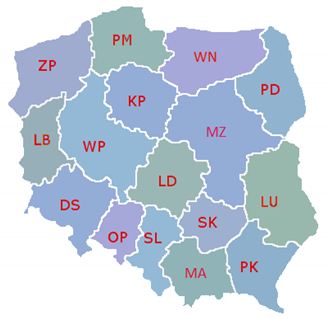 | ||
| Masovia (MZ) | C17/0.72 p = 0.002 | C17/0.78 p = 0.0004 | |||
| Opole (OP) | C14/0.78 p = 0.0004 | C26/0.62 p = 0.010 | |||
| Podkarpackie (PK) | D06/0.67 p = 0.005 | C80/0.69 p = 0.003 | |||
| Podlaskie (PD) | C33/0.87 p = 0.00001 | C88/0.61 p = 0.012 | |||
| Pomerania (PM) | C31/0.66 p = 0.005 | C31/0.75 p = 0.0008 | |||
Publisher’s Note: MDPI stays neutral with regard to jurisdictional claims in published maps and institutional affiliations. |
© 2020 by the authors. Licensee MDPI, Basel, Switzerland. This article is an open access article distributed under the terms and conditions of the Creative Commons Attribution (CC BY) license (http://creativecommons.org/licenses/by/4.0/).
Share and Cite
Tuśnio, N.; Fichna, J.; Nowakowski, P.; Tofiło, P. Air Pollution Associates with Cancer Incidences in Poland. Appl. Sci. 2020, 10, 7489. https://doi.org/10.3390/app10217489
Tuśnio N, Fichna J, Nowakowski P, Tofiło P. Air Pollution Associates with Cancer Incidences in Poland. Applied Sciences. 2020; 10(21):7489. https://doi.org/10.3390/app10217489
Chicago/Turabian StyleTuśnio, Norbert, Jakub Fichna, Przemysław Nowakowski, and Piotr Tofiło. 2020. "Air Pollution Associates with Cancer Incidences in Poland" Applied Sciences 10, no. 21: 7489. https://doi.org/10.3390/app10217489
APA StyleTuśnio, N., Fichna, J., Nowakowski, P., & Tofiło, P. (2020). Air Pollution Associates with Cancer Incidences in Poland. Applied Sciences, 10(21), 7489. https://doi.org/10.3390/app10217489






